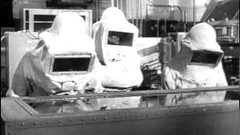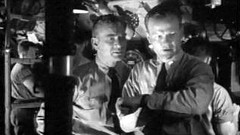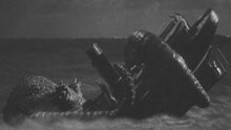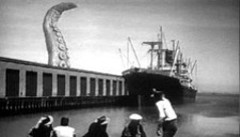|
Our
film opens with a montage of narrated
stock footage; footage that reminded me of those
old "How To" films we used to
watch back in grade school during recess
on rainy days. (Well, it was either
that or square dancing.) And while
our narrator waxes about the wonders of
atomic energy, and how we’ve barely
scratched the surface of its potential, he
also warns we must use extreme
caution with this new Pandora’s Box; for
once it has been opened, it cannot be
closed -- and
who knows what we'll find lurking inside
once we've cracked open the lead-lined lid...

Ah,
the 1950's ... A truly magical time. It was
an era when America, still wallowing in
the fact that we kicked the collective
asses of the Axis in WWII, looked to the
future: a grand era of peace, harmony and
easy living as we entered the new
push-button age, with everything powered by
our little friend the atom.
But
little
did we know what the drastic consequences
of this
tapping into God’s Domain would wreak
upon mankind; a horrible side-effect that
threatened to destroy these dreams of
utopia, rotting it away from the inside
out. And it's name was radiation -- the
unfortunate side-effect of atomic energy
and the dastardly villain of our piece.
For if we only knew the horrors it would
spawn, we probably would have left well
enough alone.
Instead,
brash and brassy, we blundered right on ahead,
with the inevitably disastrous results: a rash of films
featuring really, really big and mutated
things running amok and trying to kill us
all. And one of the first films to tap into
this new breed of paranoia was this week's
film: It
Came From Beneath the Sea.

At
the time the film was made, one of the
crowning jewels of this new technology was
the first atomic-powered submarine; and
our story proper picks up on the sub's
maiden voyage. A real beauty, the boat practically drives itself, but
operating the thing proves
so dull and tedious the crew is starting
to go a little stir crazy. And as the bored
submariners stew and fret about the
rumored sterilization effects of the
atomic-pile powering the screws, things
continue on their hum-drum course until
the sonar picks up a rather large blip
following them. Too big to be a whale,
Captain Pete
Mathews
(Ken Tobey -- thee
fan favorite here at 3B
Theater)
orders the boat to speed up and alter
course to try and shake it. But this
maneuver only causes the pursuing blip to
speed up and overtake the sub, snaring it,
and stopping it dead in the water! After a
few tense moments, whatever the heck it
was
lets them go and promptly disappears.
Sending two divers out to inspect for
damages, they find
a big chunk of something stuck in
the ballast. And the real unsettling thing
about this drum-shaped
chunk of whatever is that it appears to
be organic -- and it's also highly radioactive!
Heading
back to Pearl, Mathews gives the order
that until they get some answers, technically,
none of this ever happened. Keeping things
on the Q.T., the Navy brings in a couple
of experts; a Dr. John Carter (Donald
Curtis) and Dr. Leslie Joyce (Faith
Domergue),
to unravel the mystery.
And after running some tests
on the dismembered chunk of Specimen-X,
there is much scientific babble amongst
the eggheads, and many references to some
conference in Cairo. Hilariously, Mathews
looks just as lost as the audience during
the scientific stuff, but has every
intention of *ahem*
"test-tubing" Dr. Joyce. When
the final results come back, the experts
soon deduce the chunk is part of a
giant cephalopod (--
that’s a really big octopus to you and
me);
and when presenting their findings to
the Navy brass, they postulate that the
creature must have resided deep in the
trenches of the Pacific until the H-bomb
tests drove it to the surface. It’s
seems a reasonable theory, given the
physical evidence, but the Navy doesn’t
show much faith in their findings and
decides to just hush it all up.

Meanwhile,
the creature strikes again, sinking a
cargo ship. Only three
survivors are picked up and taken ashore,
where one of them insists a giant
octopus attacked and sank them. The other
two, not wanting to wind up in the
nut-house, won’t confirm
his story, so the first witness eventually
recants. When the Navy gets wind of this,
and faced with the mounting evidence, they
send their research group to interview
the survivors. Turning on the old feminine
charm, Joyce eventually coaxes the truth out of all
of them. And with all that corroboration,
it's official: the Navy has a giant,
ship-wrecking octopus on its hands.
So,
with the cover story of secret naval
maneuvers, all shipping in the Pacific is
shut down while a massive search and
destroy effort for the beast is put
underway. Now, since the Pacific is a
pretty big puddle of water, they decide to
concentrate on the areas that report
mysterious happenings or disappearances. One
such lead is a missing weather-monitoring
ship off the coast of Oregon. Joyce is
about to head up there alone, but when
another disappearance is reported in the
same area, Mathews and Carter decide to
tag along. Once there, the local Sheriff
takes them to the beach where they find a
wrecked car and some octopus tracks. (Yeah,
I know -- just roll with it.)
Scouring the beach with Geiger
counters, looking for more evidence, they
quickly find some when the monster
suddenly surfaces and reaches for them
with its massive tentacles. And as our
heroes beat a hasty retreat, one of those
appendages smushes the poor Sheriff.

With
the creature’s
existence now firmly established, the
focus soon shifts to finding a way to
destroy it. Seems conventional weapons
won't do the trick, according to the
experts, so, after setting up shop in San Francisco,
the Navy begins to develop an electronic
torpedo that should get the job done. (In
truth, nothing more than an aerial torpedo
with its fins removed.) And no
sooner than the new fangled torpedo’s unveiling,
the monster suddenly surfaces again and attacks the
city. For reasons that can only be
explained by the necessities of the script, the Golden Gate
Bridge has been electrified to keep the
monster away -- but it appears to have the
opposite effect. And as the monster begins to
feed on the electricity (--
I
think),
the thing actually starts to pull itself
up and out of the water! The
landmark is quickly evacuated, but the current is
left on --
and the switch is located oh-so
conveniently in the middle of the bridge!
Deducing the monster must be attracted
to the energy, Carter drives onto the
collapsing bridge to cut off the source.
He manages to get to the switch and pulls
the plug, but this kinda ticks the monster
off and it demolishes his car, trapping
him there. With the bridge on the verge of
collapse, Mathews leaves Joyce behind and
barrels onto the fluctuating roadway to save Carter.
Rounding him up, they manage to get off
just as the bridge gives out. And as it
collapses, the monstrous octopus falls
back into the bay.
But
the
monster doesn’t stay quiet for long,
however, and quickly surfaces again, near
the Market District, and tries to pull
itself ashore to probe for food! And while the
Army manages to drive the octopus back
into the water with flame-throwers, Mathews
and Carter report back to the atomic sub
with the new fangled torpedo. Once they're
onboard, the sub quickly moves out to get
a clear shot at the target. Once they get
close enough, Mathews gives the order to launch the
torpedo. They score a direct hit, but
the monster grabs them before they can get
clear, meaning
they can’t detonate the torpedo's
warhead without blowing themselves up.

They
do explain why the timing device is
needed, but I can't for the life of me
remember what it was. Sorry. Back to the
review...
In
an effort to get them loose, Mathews dons
an aqua-lung (--
which
sounds so much cooler than scuba gear --)
and swims out of the airlock. Armed
with an explosive tipped harpoon, he
plunges it into the offending tentacle.
But when it detonates, he's knocked
unconscious in the shockwave -- and worse
yet, the monster doesn’t let go!
Knowing where the monster’s
vulnerable spot is, Carter
tries next. Going for one of the
creature’s eyes, he
blasts it with another explosive
harpoon. Enraged and injured, the monster
sloshes in pain and drops the sub. Then,
as the
freed boat speeds away, Lt. Griff (Chuck
Griffith), even though his two
friends are still out in the water, obeys
his Captain’s last order and detonates
the torpedo,
turning San Francisco Bay into one big
bowl of octopus soup.
The
danger ended, the sub surfaces to happily
find both Carter and Mathews safely got
away.
The
End
I
hadn't seen this film for a while, and as
I dusted the tape off and watched it
again, It Came from Beneath the Sea
gave me a real bad case of déjà vu. The whole thing seemed a little too
familiar, and it wasn’t until the
questioning of the shipwreck survivors
that I realized this film was basically
nothing but a carbon copy of THEM!
-- the
seminal giant bug movie that came out the
year before -- and frankly, not a very good
copy, either. Not really all that
surprising once you realize George Worthing
Yates wrote both films. And he wasn't done
rehashing the same themes either. Making a
name for himself over the next few years
writing about really big stuff --
including
the English adaptation of King
Kong vs. Godzilla,
Yates squeezed a lot from this same
formula as
he bears the responsibility for most of
Bert
I. Gordon's giant-thingies on the loose
boon-doggles. The actors involved are
all game, and director Robert Gordon, with
nothing really to shoot except the clumsy
banter between the three points of one of
the strangest love-triangles in cinematic
history, manages to keep the pace moving
nicely between the F/X shots.
Admittedly,
as the film's main selling point, this
isn’t one of Ray Harryhausen’s best
efforts but I think it's still worth the
time. To stage the climactic attack on San
Francisco, the production company wound up
having to sneak shots of the famous
landmarks around the city. I guess the
city fathers got wind that the Golden Gate
Bridge, among other things, was destined
to be destroyed in the film. And the
mayor, not realizing that the monster was
a miniature effect, believed the bridge
would suffer massive structural damage
while trying to support a giant octopus
prop and refused to issue them the proper
filming permits. (Another
version of the story states the city
fathers refused to lose the toll-money
while the bridge was shut down for
filming.) Hiding the camera in a
bread truck, they drove across the bridge
a couple of times to get the shots they
needed. However, word of this subterfuge
soon leaked out and the mayor retaliated
by rescinding the production company's
parking permits, meaning the cameras had
to constantly be on the move or face a
hefty fine.
If
nothing else, the film should be
recognized as the first joint project
between Harryhausen and producer Charles
H. Schneer. Impressed with Harryhausen's
work on The
Beast from 20000 Fathoms,
it was Schneer who put out the feelers
first, hoping lightning would strike twice
with his own project, tentatively titled, Monster
from the Deep. The two hit it off, and
together, they would entertain us with
many a fantasy matinee
yarn for years to come. Under the wing of
executive-producer -- and well known
cheapskate -- Sam Katzman for Columbia
Pictures, this probably goes a long way in
explaining why the budget-strapped octopus
had six tentacles instead of the customary
eight, though Katzman would later chide
that he paid Harryhausen (an
egregious overestimation of) $10000
per tentacle. This would also explain the
strange, abrupt shift in the lop-sided
love triangle between the three leads.
According to an interview with Tobey, one
of the last things to be shot was the love
scene between him and Domergue, where he
finally wins the girl over. Before the
cameras rolled, however, Katzman, as was his
custom, consulted with his director and
then proceeded to rip the pages from the
script, ending the the six day shoot. (Did
Katzman do with this with every picture he
made?) To also keep costs down,
shooting in color and cinemascope was also
scrapped, and, in the end, they brought the
production in for about $150,000. And just
like
Beast before it, It
Came from Beneath the Sea
was a box-office success, prompting
Katzman to push Schneer for an immediate
follow-up, which eventually turned out to
be Earth
vs. the Flying Saucers.
If
this isn't your first rodeo, then It
Came from Beneath the Sea
is nothing you probably haven't seen
before; but you could do a lot worse than
spending an afternoon with it. So crack a
few brews, think back with fond memories
to that awesome conference in Cairo, complete
with Ms. Domergue in a string bikini, and
enjoy the show.
|